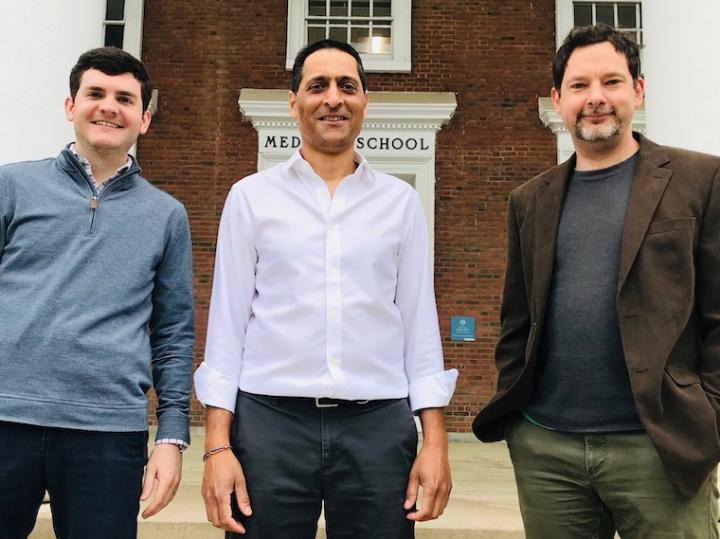
Credit: Courtesy Patel lab
New research from the University of Virginia School of Medicine has shed light on the No. 1 cause of epilepsy deaths, suggesting a long-sought answer for why some patients die unexpectedly following an epileptic seizure.
The researchers found that a certain type of seizure is associated with sudden death in a mouse model of epilepsy and that death occurred only when the seizure induced failure of the respiratory system.
The new understanding will help scientists in their efforts to develop ways to prevent sudden unexpected death in epilepsy (SUDEP). Based on their research, the UVA team has already identified potential approaches to stimulate breathing in the mice and prevent death after a seizure. The team believe that this new approach could one day help save lives.
“SUDEP is a major concern for patients with epilepsy and their loved ones,” said Manoj Patel, PhD, of UVA’s Department of Anesthesiology. “Our study has identified a sequence of events that takes place during a seizure which can progress and lead to death. Furthermore, we show that intervention during a seizure can rescue death in mice with epilepsy. This project is a long time in the making, and we are excited to share it with the scientific community.”
Sudden Unexpected Death in Epilepsy
Many people were unfamiliar with sudden unexpected death in epilepsy when it took the life of young Disney Channel star Cameron Boyce in 2019. He was only 20 years old. SUDEP, however, is the most common cause of epilepsy-related death. Estimates suggest it is responsible for 8% to 17% of all epilepsy deaths, increasing to 50% in patients whose seizures do not respond to treatment.
Scientists have suggested a variety of potential causes for SUDEP, but UVA’s researchers have brought clarity to why some seizures lead to death while others do not and how we may be able to prevent progression to death.
The researchers found that breathing disruption, known as apnea, began during seizures, as muscles start to stiffen. This stiffening included contraction of the diaphragm, the major breathing muscle, that prevented exhalation, stopping the normal breathing process.
Not all instances of this seizure-induced apnea were fatal; it was only when breathing did not recover immediately after the seizure that the mice died, the researchers found. The UVA team reasoned that artificially stimulating breathing would help prevent sudden death after a seizure. Indeed, in a mouse model of epilepsy, they determined that death could be prevented by directly ventilating the mouse.
While their work was in lab mice, they confirmed their findings by monitoring breathing frequency and patterns in a human patient with epilepsy. They found there were breathing disruptions, or apneas, during seizures that were very similar to those seen in their mice.
“These results implicate respiratory arrest as a major factor in SUDEP and give us targets for future research on intervention,” said researcher Ian Wenker, PhD.
Using their innovative new SUDEP model, the UVA researchers have identified potential avenues for preventing SUDEP. One might be to target “adrenergic” receptors that regulate the body’s response to adrenaline and other neurotransmitters. These receptors, the scientists found, are vital to restarting breathing after a seizure and preventing death.
“By identifying some of the receptors involved in stimulating breathing recovery following a seizure, we believe our findings will fuel other approaches to help reduce the risk of death in epilepsy patients,” said researcher Eric Wenger, a graduate student. “We’re eager for other researchers to use our new model to expand our understanding and ability to prevent SUDEP.”
###
Findings Published
The researchers have published their findings in a pair of new papers in the scientific journals Annals of Neurology and Frontiers in Neuroscience. The former was authored by Ian C. Wenker, Frida A. Teran, Eric R. Wengert, Pravin K. Wagley, Payal S. Panchal, Elizabeth A. Blizzard, Priyanka Saraf, Jacy L. Wagnon, Howard P. Goodkin, Miriam H. Meisler, George B. Richerson and Manoj K. Patel. The latter was authored by Eric R. Wengert, Ian C. Wenker, Elizabeth L. Wagner, Pravin K. Wagley, Ronald P. Gaykema, Jung-Bum Shin and Manoj K. Patel.
The research was supported by the National Institutes of Health, grants R01NS103090, 1F31NS115451-01, R01DC014254 and F31DC017370; the National Institute of Neurological Disorders and Stroke, grants NS034509, NS090414, NS103090 and NS110333; Citizens United for Research in Epilepsy; Wishes for Elliot and the UVA Department of Anesthesiology.
To keep up with the latest medical research news from UVA, subscribe to the Making of Medicine blog at http://makingofmedicine.
Media Contact
Josh Barney
[email protected]
Original Source
https:/
Related Journal Article
http://dx.




